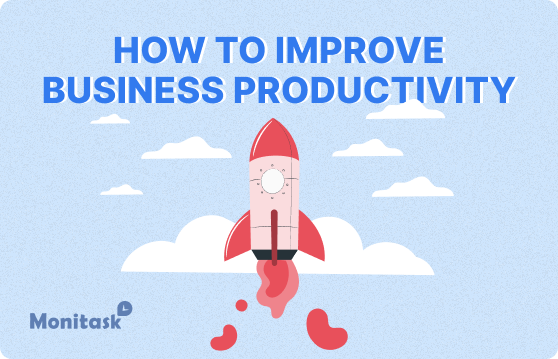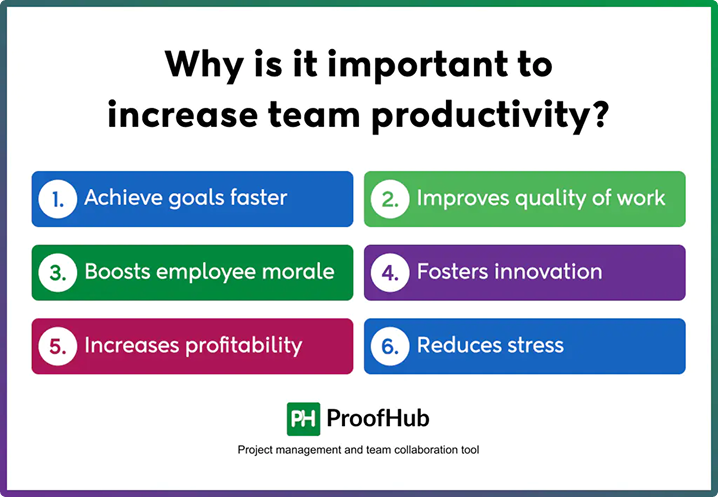How to Improve Business Productivity: 19 Strategies for Success

Business productivity refers to the efficiency with which a company converts resources—such as labor, capital, and materials—into valuable products and services.
It is a key metric for measuring the overall performance of a business, ensuring that operations run smoothly while maximizing output with minimal waste.
Why Is Business Productivity Important?
Productivity directly impacts a company’s profitability, competitiveness, and sustainability.
High productivity leads to increased revenue, improved customer satisfaction, and a better work environment.
Businesses that focus on enhancing productivity can reduce operational costs, optimize resource allocation, and adapt more effectively to market demands.

What Can a Business Do to Improve Its Productivity?
1. Assess the Need for Productivity Improvements
Before implementing changes, businesses must evaluate their current productivity levels. Identifying bottlenecks, inefficiencies, and performance gaps allows organizations to develop targeted strategies for improvement.
2. Define Clear and Measurable Goals
Setting specific, measurable, achievable, relevant, and time-bound (SMART) goals helps businesses track progress and maintain focus. Clearly defined objectives ensure that employees understand expectations and work toward common goals.
3. Establish and Track Key Performance Metrics
Using Key Performance Indicators (KPIs) to monitor productivity ensures accountability. Metrics such as employee output, revenue per employee, and operational efficiency provide valuable insights into overall performance.
4. Enhance Employee Efficiency and Engagement
Motivated and engaged employees are more productive. Encouraging open communication, recognizing achievements, and fostering a positive work environment can significantly boost efficiency.

5. Offer Training Opportunities to Employees
Continuous learning and development help employees stay updated with industry trends and acquire new skills. Investing in training programs improves job performance and increases employee retention.
6. Delegate Accordingly
Effective delegation ensures that tasks are assigned to employees based on their strengths and expertise. This prevents burnout, enhances teamwork, and improves overall efficiency.
7. Reduce Workplace Distractions
Minimizing workplace distractions, such as unnecessary meetings and excessive notifications, allows employees to maintain focus. Implementing quiet workspaces and enforcing structured schedules can improve concentration.
8. Identify and Eliminate Inefficiencies
Streamlining processes and eliminating redundant tasks enhance operational efficiency. Regular process reviews help businesses identify areas that need optimization.
9. Restructure for Efficiency
Organizational restructuring may be necessary to improve workflow. Businesses should assess team structures and adjust roles and responsibilities for better alignment with company objectives.
Maximize productivity of your business
Track employee productivity and simplify work with them
10. Upgrade Workplace Conditions
A comfortable and well-equipped workspace enhances productivity. Investing in ergonomic furniture, proper lighting, and modern technology can improve employee performance and well-being.
11. Provide Support and Set Realistic Targets
Employees perform better when they receive adequate support from management. Setting realistic expectations and providing necessary resources help reduce stress and increase job satisfaction.
12. Reward Employee Performance
Recognizing and rewarding high-performing employees boosts morale and motivation. Incentives such as bonuses, promotions, and public recognition encourage a culture of excellence.
13. Leverage Advanced Technology for Growth
Implementing modern tools and software enhances efficiency. Cloud-based systems, artificial intelligence, and data analytics help businesses automate processes and improve decision-making.
14. Optimize Processes Through Automation
Automation reduces manual labor and minimizes errors. Businesses can automate repetitive tasks, such as data entry and invoicing, to save time and resources.

15. Foster a Collaborative and Team-Oriented Workplace
Encouraging teamwork and open communication fosters a more productive work environment. Collaboration tools and regular team meetings improve coordination and efficiency.
16. Cultivate a Mindset of Continuous Improvement
Adopting a culture of continuous improvement ensures long-term success. Businesses should encourage innovation, regularly review performance, and make necessary adjustments to stay competitive.
17. Analyze Performance and Adapt for Ongoing Success
Regular performance evaluations help businesses identify strengths and areas for improvement. Using feedback and data-driven insights allows organizations to refine strategies for sustained productivity.
18. Strengthen Customer and Client Relations
Satisfied customers contribute to business growth. Improving customer service, responding to feedback, and maintaining strong client relationships enhance productivity and profitability.
19. Improve Work-Life Balance and Employee Well-Being
Providing flexible work arrangements and promoting a healthy work-life balance reduces burnout and improves employee retention. Happy and well-rested employees are more productive and engaged.

Conclusion
Improving business productivity requires a strategic and multifaceted approach.
By setting clear goals, leveraging technology, investing in employee development, and fostering a culture of continuous improvement, businesses can optimize efficiency and achieve long-term success.
– The Monitask Team
Frequently Asked Questions
What are the 5 main factors that affect productivity?
The five main factors that affect productivity are:
– Workforce efficiency – Skilled and motivated employees enhance productivity.
– Technology and tools – Advanced technology improves efficiency and reduces manual effort.
– Workplace environment – A comfortable and distraction-free workspace boosts focus.
– Management and leadership – Effective leadership ensures smooth operations and clear objectives.
– Process optimization – Streamlined workflows reduce waste and improve output.
How to improve the efficiency of a business?
To improve business efficiency, companies should implement automation, leverage technology, set clear goals, delegate tasks effectively, and continuously analyze performance. Encouraging employee engagement and fostering a culture of improvement also contribute to higher efficiency.



